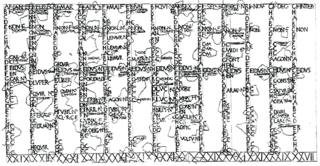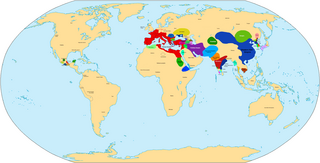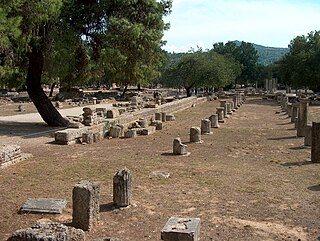Births
This section is empty.You can help by adding to it.(January 2015) |
| Millennium: | 1st millennium BC |
|---|---|
| Centuries: | |
| Decades: | |
| Years: |
| 581 BC by topic |
| Politics |
|---|
| Categories |
| Gregorian calendar | 581 BC DLXXX BC |
| Ab urbe condita | 173 |
| Ancient Egypt era | XXVI dynasty, 84 |
| - Pharaoh | Apries, 9 |
| Ancient Greek era | 49th Olympiad, year 4 |
| Assyrian calendar | 4170 |
| Balinese saka calendar | N/A |
| Bengali calendar | −1173 |
| Berber calendar | 370 |
| Buddhist calendar | −36 |
| Burmese calendar | −1218 |
| Byzantine calendar | 4928–4929 |
| Chinese calendar | 己卯年 (Earth Rabbit) 2116 or 2056 — to — 庚辰年 (Metal Dragon) 2117 or 2057 |
| Coptic calendar | −864 – −863 |
| Discordian calendar | 586 |
| Ethiopian calendar | −588 – −587 |
| Hebrew calendar | 3180–3181 |
| Hindu calendars | |
| - Vikram Samvat | −524 – −523 |
| - Shaka Samvat | N/A |
| - Kali Yuga | 2520–2521 |
| Holocene calendar | 9420 |
| Iranian calendar | 1202 BP – 1201 BP |
| Islamic calendar | 1239 BH – 1238 BH |
| Javanese calendar | N/A |
| Julian calendar | N/A |
| Korean calendar | 1753 |
| Minguo calendar | 2492 before ROC 民前2492年 |
| Nanakshahi calendar | −2048 |
| Thai solar calendar | −38 – −37 |
| Tibetan calendar | 阴土兔年 (female Earth-Rabbit) −454 or −835 or −1607 — to — 阳金龙年 (male Iron-Dragon) −453 or −834 or −1606 |
The year 581 BC was a year of the pre-Julian Roman calendar. In the Roman Empire, it was known as year 173 Ab urbe condita . The denomination 581 BC for this year has been used since the early medieval period, when the Anno Domini calendar era became the prevalent method in Europe for naming years.
This section is empty.You can help by adding to it.(January 2015) |
The Julian calendar, proposed by Julius Caesar in 708 Ab urbe condita (AUC) (46 BC), was a reform of the Roman calendar. It took effect on 1 January 709 AUC (45 BC), by edict. It was designed with the aid of Greek mathematicians and Greek astronomers such as Sosigenes of Alexandria.

Gaius Julius Caesar, known simply as Julius Caesar, was a Roman general and statesman who played a critical role in the events that led to the demise of the Roman Republic and the rise of the Roman Empire. He was also a historian and author of Latin prose.
A leap year is a calendar year that contains an additional day added to keep the calendar year synchronized with the astronomical year or seasonal year. Because astronomical events and seasons do not repeat in a whole number of days, calendars that have the same number of days in each year drift over time with respect to the event that the year is supposed to track. By inserting an additional day or month into the year, the drift can be corrected. A year that is not a leap year is a common year.

New Year is the time or day at which a new calendar year begins and the calendar's year count increments by one.

The Roman calendar was the calendar used by the Roman kingdom and republic. The term often includes the Julian calendar established by the reforms of the dictator Julius Caesar and emperor Augustus in the late 1st century BC and sometimes includes any system dated by inclusive counting towards months' kalends, nones, and ides in the Roman manner. The term usually excludes the Alexandrian calendar of Roman Egypt, which continued the unique months of that land's former calendar; the Byzantine calendar of the later Roman Empire, which usually dated the Roman months in the simple count of the ancient Greek calendars; and the Gregorian calendar, which refined the Julian system to bring it into still closer alignment with the tropical year.
Year 12 BC was either a common year starting on Saturday, Sunday or Monday or a leap year starting on Sunday of the Julian calendar and a common year starting on Friday of the Proleptic Julian calendar. At the time, it was known as the Year of the Consulship of Messalla and Quirinius. The denomination 12 BC for this year has been used since the early medieval period, when the Anno Domini calendar era became the prevalent method in Europe for naming years.

AD 1 (I), 1 AD or 1 CE is the epoch year for the Anno Domini calendar era. It was the first year of the Common Era (CE), of the 1st millennium and of the 1st century. It was a common year starting on Saturday or Sunday, a common year starting on Saturday by the proleptic Julian calendar, and a common year starting on Monday by the proleptic Gregorian calendar. In its time, year 1 was known as the Year of the Consulship of Caesar and Paullus, named after Roman consuls Gaius Caesar and Lucius Aemilius Paullus, and less frequently, as year 754 AUC within the Roman Empire. The denomination "AD 1" for this year has been in consistent use since the mid-medieval period when the anno Domini (AD) calendar era became the prevalent method in Europe for naming years. It was the beginning of the Christian/Common era. The preceding year is 1 BC; there is no year 0 in this numbering scheme. The Anno Domini dating system was devised in AD 525 by Dionysius Exiguus.
The proleptic Julian calendar is produced by extending the Julian calendar backwards to dates preceding AD 8 when the quadrennial leap year stabilized. The leap years that were actually observed between the implementation of the Julian calendar in 45 BC and AD 8 were erratic: see the Julian calendar article for details.

The Ides of March is the 74th day in the Roman calendar that corresponds to 15 March. It was marked by several religious observances and was notable for the Romans as a deadline for settling debts. In 44 BC, it became notorious as the date of the assassination of Julius Caesar which made the Ides of March a turning point in Roman history.
An epoch, for the purposes of chronology and periodization, is an instant in time chosen as the origin of a particular calendar era. The "epoch" serves as a reference point from which time is measured.
Year 8 BC was either a common year starting on Friday or Saturday or a leap year starting on Thursday of the Julian calendar and a common year starting on Wednesday of the Proleptic Julian calendar. At the time, it was known as the Year of the Consulship of Censorinus and Gaius Asinius. The denomination 8 BC for this year has been used since the early medieval period, when the Anno Domini calendar era became the prevalent method in Europe for naming years.
Year 46 BC was the last year of the pre-Julian Roman calendar. At the time, it was known as the Year of the Consulship of Caesar and Lepidus. The denomination 46 BC for this year has been used since the early medieval period, when the Anno Domini calendar era became the prevalent method in Europe for naming years.
Year 45 BC was either a common year starting on Thursday, Friday or Saturday or a leap year starting on Friday or Saturday and the first year of the Julian calendar and a leap year starting on Friday of the Proleptic Julian calendar. At the time, it was known as the Year of the Consulship of Caesar without Colleague. The denomination 45 BC for this year has been used since the early medieval period, when the Anno Domini calendar era became the prevalent method in Europe for naming years.
Year 173 BC was a year of the pre-Julian Roman calendar. At the time it was known as the Year of the Consulship of Albinus and Laenas. The denomination 173 BC for this year has been used since the early medieval period, when the Anno Domini calendar era became the prevalent method in Europe for naming years.

An Olympiad is a period of four years associated with the Olympic Games of the Ancient Greeks. Although the Ancient Olympic Games were established during Archaic Greece, it was not until the Hellenistic period, beginning with Ephorus, that the Olympiad was used as a calendar epoch. Converting to the modern BC/AD dating system the first Olympiad began in the summer of 776 BC and lasted until the summer of 772 BC, when the second Olympiad would begin with the commencement of the next games. By extrapolation to the Julian calendar, the 4th year of the 699th Olympiad began in (Northern-Hemisphere) mid-summer 2020.
A calendar era is the period of time elapsed since one epoch of a calendar and, if it exists, before the next one. For example, the Gregorian calendar numbers its years in the Western Christian era.
The Ancient Macedonian calendar is a lunisolar calendar that was in use in ancient Macedon in the 1st millennium BC. It consisted of 12 synodic lunar months, which needed intercalary months to stay in step with the seasons. By the time the calendar was being used across the Hellenistic world, seven total embolimoi were being added in each 19-year Metonic cycle. The names of the ancient Macedonian Calendar remained in use in Syria even into the Christian era. The Macedonian calendar was in essence the Babylonian calendar with the substitution of Macedonian names for the Babylonian ones. An example of 6th century AD inscriptions from Decapolis, Jordan, bearing the Solar Macedonian calendar, starts from the month Audynaeus. The solar type was merged later with the Julian calendar. In Roman Macedonia, both calendars were used. The Roman one is attested in inscriptions with the name Kalandôn gen. καλανδῶν calendae and the Macedonian Hellenikei dat. Ἑλληνικῇ Hellenic. Finally an inscription from Kassandreia of about ca. 306-298 BC bearing a month Ἀθηναιῶν Athenaion suggests that some cities may have used their own months even after the 4th century BC Macedonian expansion.
The year zero does not exist in the Anno Domini (AD) system commonly used to number years in the Gregorian calendar and in its predecessor, the Julian calendar. In this system, the year 1 BC is followed by AD 1. However, there is a year zero in astronomical year numbering and in ISO 8601:2004, as well as in all Buddhist and Hindu calendars.
The Gregorian calendar is the calendar used in most of the world. It is named after Pope Gregory XIII, who introduced it in October 1582.
Papyrus Oxyrhynchus 581 is a papyrus fragment written in Ancient Greek, apparently recording the sale of a slave girl. Dating from 29 August 99 AD, P. Oxy. 581 was discovered, alongside hundreds of other papyri, by Bernard Pyne Grenfell and Arthur Surridge Hunt while excavating an ancient landfill at Oxyrhynchus in modern Egypt. The document's contents were published by the Egypt Exploration Fund in 1898, which also secured its donation to University College, Dundee, later the University of Dundee, in 1903 – where it still resides. Measuring 6.3 x 14.7 cm and consisting of 17 lines of text, the artifact represents the conclusion of a longer record, although the beginning of the papyrus was lost before it was found. P. Oxy. 581 has received a modest amount of scholarly attention, most recently and completely in a 2009 translation by classicist Amin Benaissa of Lady Margaret Hall, Oxford.
| This BC year article is a stub. You can help Wikipedia by expanding it. |